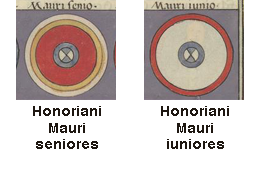
This page created 3 August 2014, and last modified: 29 October (Frankfurt fragment image added)

One of the auxilia palatina units in the Magister Peditum's infantry roster is named the Honoriani Mauri iuniores; it is assigned to his Italian command under the name Mauri Honoriani iuniores. Its shield pattern in various manuscripts, under the label Mauri iuniores, is as shown below:

The pattern is simple, with a white boss quartered with indigo (with white in W) and encircled by an indigo band (albeit more urple than indigo in B). The shield has a red rim and the main ground is white. Although there is evidence that many labels attached to the shield patterns illustrating the western auxilia platina have been shifted from their proper place, it is not clear that this has happened to this unit; it may well be labelled with the correct shield pattern. In particular, while the combination of red rim and white main ground is common in the Notitia, it is notable, however, that the pattern for previous unit in the Magister Peditum's infantry roster, the Honoriani Mauri seniores, reverses these colours, as a comparison of the following patterns taken from the Parisian manuscript shows:

That two such clearly related units should have what apparently are related shield pattens would indicate that, for this portion of the roster at least, the labels and the patterns are back in synchronicity (note that quartered shield bosses are very rare for auxilia palatina units).
The name Mauri denotes the Moorish peoples, although there is every indication that by this date the term, as used used in the Roman military, denoted not an ethnicity but a particular kind of military unit. However, exactly what kind is hard to say (probably a light unit; whether of horse or, as in this case, of foot), as it is very likely that this meaning had also been superseded with time (most Roman infantry units likely having their own integral light troops by the time of the Notitia), leaving the name doubly fossilized!
The name Honoriani refers to the emperor Honorius, who succeeded his father Theodosius I in 395, around the time the Notitia was first compiled. Note that Honorius had however, been declared co-Augustus two years earlier, at the age of 7, so the presence of units bearing the name Honorius does not therefore prove they must have been entered into the document so-named at 395 at the earliest. Nonetheless, the presence of large numbers of units named after Honorius in the western half of the Notitia, compared to very few in the east, is one of the clearest indications the eastern portion was not amended much, or even at all, after the death of Theodosius, while the western half was extensively updated.

Return to the Notitia alphabetical unit list page.
Return to my Notitia index page.